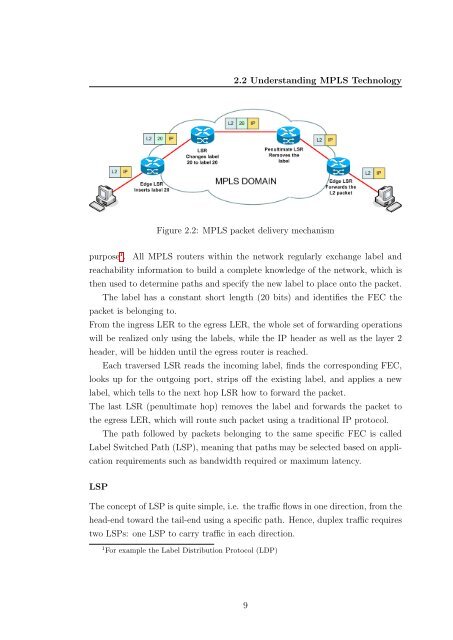Davide Cherubini - PhD Thesis - UniCA Eprints
Davide Cherubini - PhD Thesis - UniCA Eprints
Davide Cherubini - PhD Thesis - UniCA Eprints
You also want an ePaper? Increase the reach of your titles
YUMPU automatically turns print PDFs into web optimized ePapers that Google loves.
2.2 Understanding MPLS TechnologyFigure 2.2: MPLS packet delivery mechanismpurpose 1 . All MPLS routers within the network regularly exchange label andreachability information to build a complete knowledge of the network, which isthen used to determine paths and specify the new label to place onto the packet.The label has a constant short length (20 bits) and identifies the FEC thepacket is belonging to.From the ingress LER to the egress LER, the whole set of forwarding operationswill be realized only using the labels, while the IP header as well as the layer 2header, will be hidden until the egress router is reached.Each traversed LSR reads the incoming label, finds the corresponding FEC,looks up for the outgoing port, strips off the existing label, and applies a newlabel, which tells to the next hop LSR how to forward the packet.The last LSR (penultimate hop) removes the label and forwards the packet tothe egress LER, which will route such packet using a traditional IP protocol.The path followed by packets belonging to the same specific FEC is calledLabel Switched Path (LSP), meaning that paths may be selected based on applicationrequirements such as bandwidth required or maximum latency.LSPThe concept of LSP is quite simple, i.e. the traffic flows in one direction, from thehead-end toward the tail-end using a specific path. Hence, duplex traffic requirestwo LSPs: one LSP to carry traffic in each direction.1 For example the Label Distribution Protocol (LDP)9
















